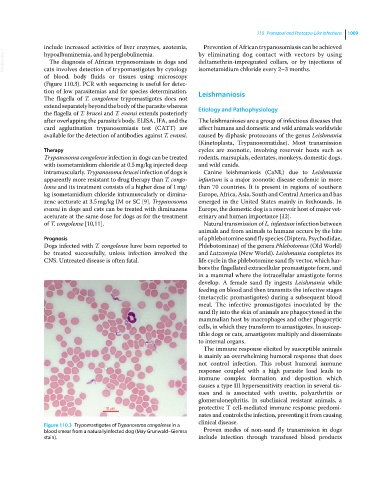Page 1071 - Clinical Small Animal Internal Medicine
P. 1071
110 Protozoal and Protozoa‐Like Infections 1009
include increased activities of liver enzymes, azotemia, Prevention of African trypanosomiasis can be achieved
VetBooks.ir hypoalbuminemia, and hyperglobulinemia. by eliminating dog contact with vectors by using
deltamethrin‐impregnated collars, or by injections of
The diagnosis of African trypnosomiasis in dogs and
cats involves detection of trypomastigotes by cytology
of blood, body fluids or tissues using microscopy isometamidium chloride every 2–3 months.
(Figure 110.3). PCR with sequencing is useful for detec-
tion of low parasitemias and for species determination. Leishmaniosis
The flagella of T. congolense trypomastigotes does not
extend separately beyond the body of the parasite whereas Etiology and Pathophysiology
the flagella of T. brucei and T. evansi extends posteriorly
after overlapping the parasite’s body. ELISA, IFA, and the The leishmanioses are a group of infectious diseases that
card agglutination trypanosomiasis test (CATT) are affect humans and domestic and wild animals worldwide
available for the detection of antibodies against T. evansi. caused by diphasic protozoans of the genus Leishmania
(Kinetoplasta, Trypanosomatidae). Most transmission
Therapy cycles are zoonotic, involving reservoir hosts such as
Trypanosoma congolense infection in dogs can be treated rodents, marsupials, edentates, monkeys, domestic dogs,
with isometamidium chloride at 0.5 mg/kg injected deep and wild canids.
intramuscularly. Trypanosoma brucei infection of dogs is Canine leishmaniosis (CaNL) due to Leishmania
apparently more resistant to drug therapy than T. congo- infantum is a major zoonotic disease endemic in more
lense and its treatment consists of a higher dose of 1 mg/ than 70 countries. It is present in regions of southern
kg isometamidium chloride intramuscularly or dimina- Europe, Africa, Asia, South and Central America and has
zene aceturate at 3.5 mg/kg IM or SC [9]. Trypanosoma emerged in the United States mainly in foxhounds. In
evansi in dogs and cats can be treated with diminazene Europe, the domestic dog is a reservoir host of major vet-
aceturate at the same dose for dogs as for the treatment erinary and human importance [12].
of T. congolense [10,11]. Natural transmission of L. infantum infection between
animals and from animals to humans occurs by the bite
Prognosis of a phlebotomine sand fly species (Diptera, Psychodidae,
Dogs infected with T. congolense have been reported to Phlebotominae) of the genera Phlebotomus (Old World)
be treated successfully, unless infection involved the and Lutzomyia (New World). Leishmania completes its
CNS. Untreated disease is often fatal. life cycle in the phlebotomine sand fly vector, which har-
bors the flagellated extracellular promastigote form, and
in a mammal where the intracellular amastigote forms
develop. A female sand fly ingests Leishmania while
feeding on blood and then transmits the infective stages
(metacyclic promastigotes) during a subsequent blood
meal. The infective promastigotes inoculated by the
sand fly into the skin of animals are phagocytosed in the
mammalian host by macrophages and other phagocytic
cells, in which they transform to amastigotes. In suscep-
tible dogs or cats, amastigotes multiply and disseminate
to internal organs.
The immune response elicited by susceptible animals
is mainly an overwhelming humoral response that does
not control infection. This robust humoral immune
response coupled with a high parasite load leads to
immune complex formation and deposition which
causes a type III hypersensitivity reaction in several tis-
sues and is associated with uveitis, polyarthritis or
glomerulonephritis. In subclinical resistant animals, a
10 m protective T cell‐mediated immune response predomi-
nates and controls the infection, preventing it from causing
clinical disease.
Figure 110.3 Trypomastigotes of Trypanosoma congolense in a
blood smear from a naturallyinfected dog (May Grunwald–Giemsa Proven modes of non-sand fly transmission in dogs
stain). include infection through transfused blood products

